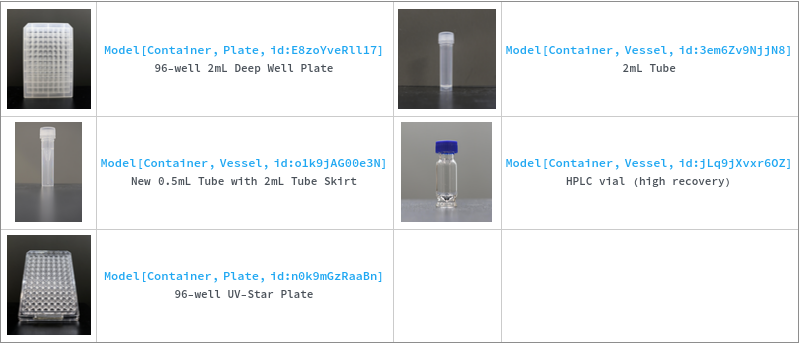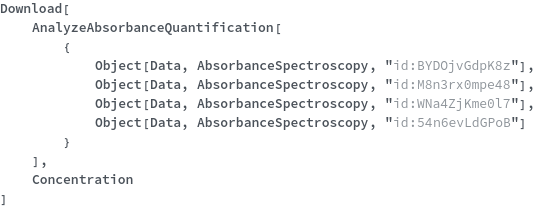AbsorbanceSpectroscopy
AbsorbanceSpectroscopy[options]⟹unitOperation
measures the absorbance spectroscopy data of the input samples.
Absorbance spectroscopy studies how much ultraviolet and visible light radiation the sample absorbs and transmits. Samples are exposed to light at a range of wavelengths, and the absorbance is measured by determining how much light at is transmitted through the sample across all these wavelengths. Because the absorbance of a substance at a given wavelength is directly proportional to its concentration, this experiment can be used to quantify how much of a substance is present in a given sample.
Experimental Principles
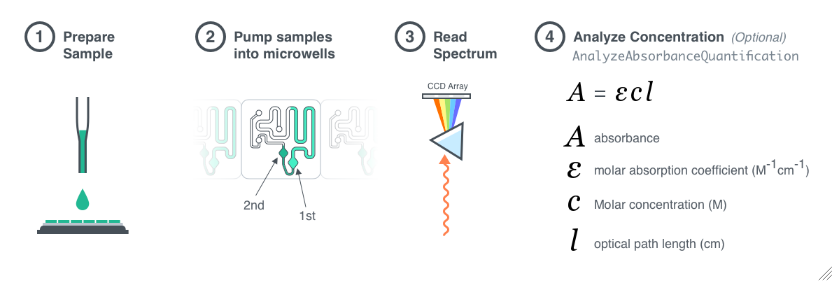
Figure 1.1: Procedural overview of an AbsorbanceSpectroscopy experiment using a Lunatic plate reader. Step 1: Microfluidic chips are loaded with sample. Step 2: Samples are pumped into the large (1st) and small (2nd) cuvettes along the microfluidic flow path. Step 3: The absorbance spectrum is collected for each of the samples, using either the larger or smaller of the cuvettes depending on how strong the absorbance is. Step 4 (optional): The concentration of the samples is determined using the Beer-Lambert Law.

Figure 1.2: Procedural overview of an AbsorbanceSpectroscopy experiment using the PHERAstar FS, FLUOstar Omega, or CLARIOstar plate readers. Step 1: Plate is loaded with sample. Step 2: The volume of each sample is measured ultrasonically to calculate path length. Step 3: The absorbance spectrum is collected for each of the samples. Step 4 (optional): The concentration of the samples is determined using the Beer-Lambert Law.
Instrumentation

Lunatic

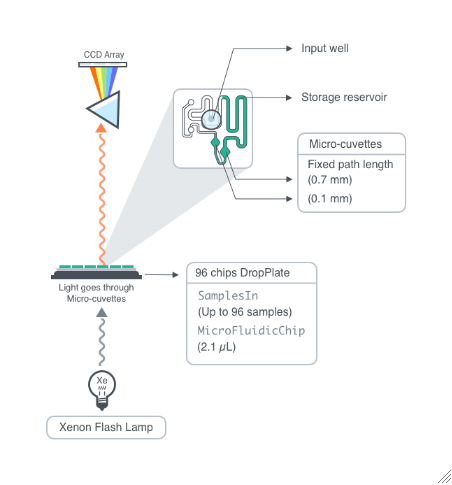
Figure 2.1.1: In the Lunatic, a Xenon Flash Lamp sends photons through the large and small cuvettes of each microfluidic chip. The light that is not absorbed is then directed through a prism which splits the beam into wavelengths from 230 nm to 750 nm that are measured by the detector.
CLARIOstar

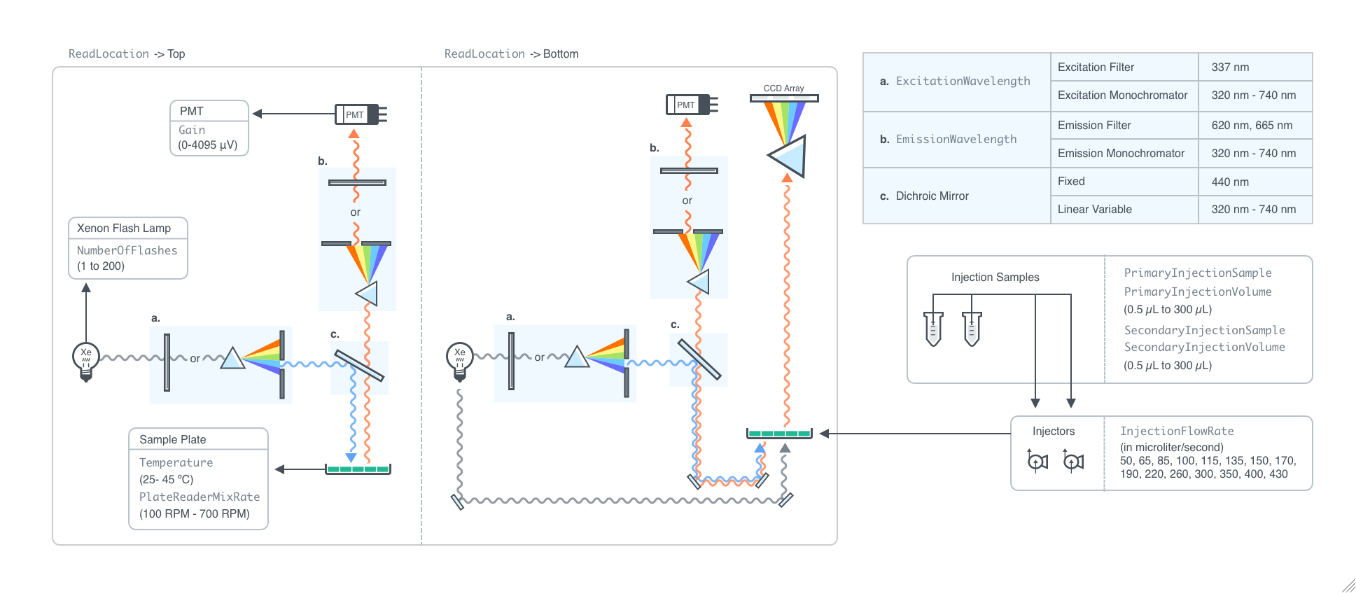
Figure 2.2.1: In the CLARIOstar, a Xenon Flash Lamp sends photons through each well of the plate. The light that is not absorbed is then directed through a prism which splits the beam into wavelengths from 220 nm to 1000 nm that are measured by the detector.
The plate chamber can be heated up to 45°C and it can mix the plate at up to 700 RPM before the run.
The reader has two 300μL syringe pump injectors which can be used for 0.5 - 300 μL injections of two unique samples prior to the run.
FLUOstar Omega

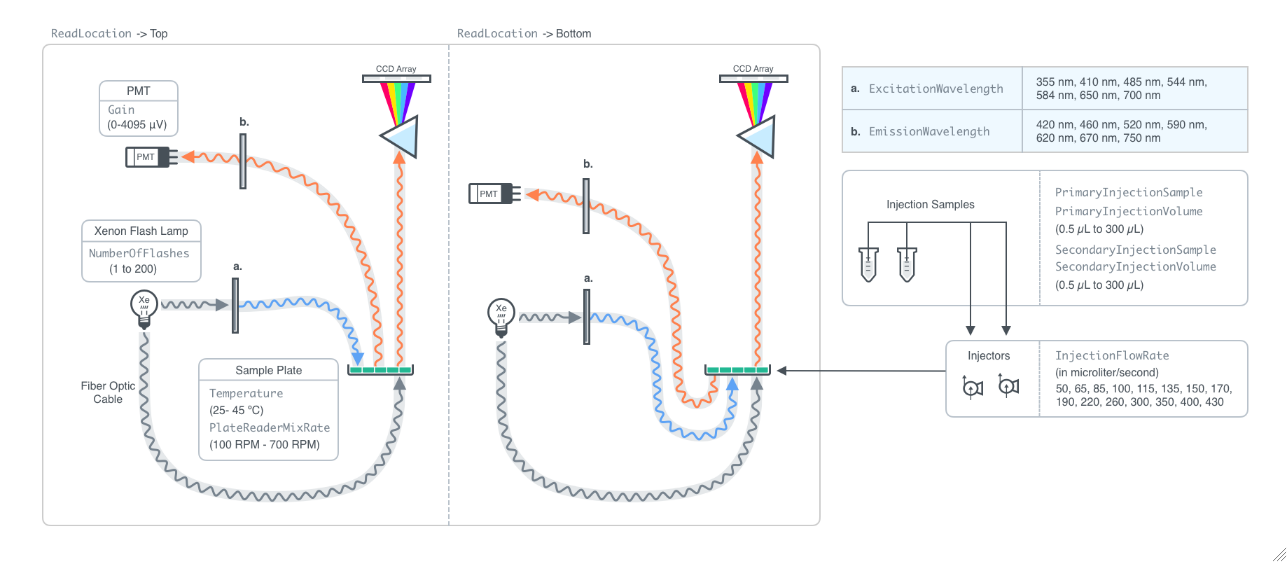
Figure 2.3.1: In the Omega, a Xenon Flash Lamp sends photons through each well of the plate. The light that is not absorbed is then directed through a prism which splits the beam into wavelengths from 220 nm to 1000 nm that are measured by the detector.
The plate chamber can be heated up to 45°C and it can mix the plate at up to 700 RPM before the run.
The reader has two 300μL syringe pump injectors which can be used for 0.5 - 300 μL injections of two unique samples prior to the run.
PHERAstar FS

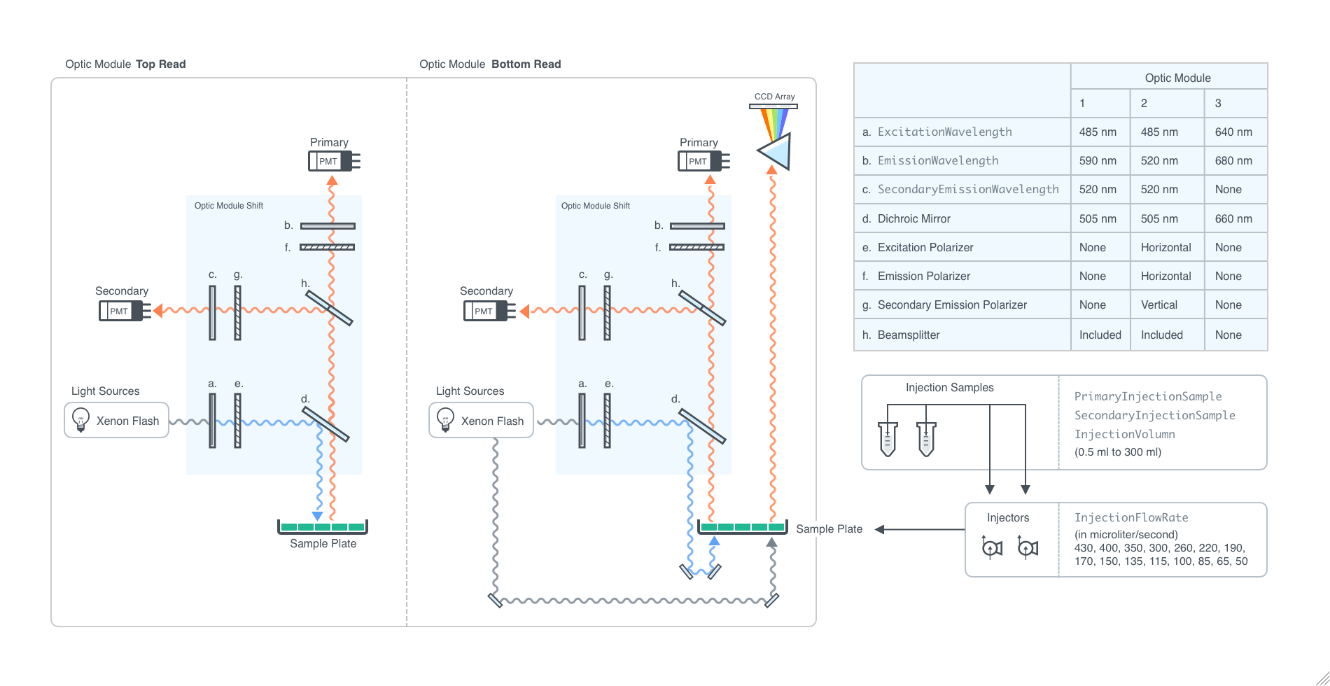
Figure 2.4.1: In the PHERAstar, a Xenon Flash Lamp sends photons through each well of the plate. The light that is not absorbed is then directed through a prism which splits the beam into wavelengths from 220 nm to 1000 nm that are measured by the detector.
The plate chamber can be heated up to 45°C and it can mix the plate at up to 700 RPM before the run.
The reader has two 300μL syringe pump injectors which can be used for 0.5 - 300 μL injections of two unique samples prior to the run.
Experiment Options
General
Sample
BlankLabel
Instrument
Default Calculation: Automatically resolves to Model[Instrument, PlateReader, "FLUOstar Omega"] if Temperature, EquilibrationTime, or any of the PlateReaderMix options are specified, or Model[Instrument, PlateReader, "Lunatic"] otherwise.
Preparation
Indicates if this unit operation is carried out primarily robotically or manually. Manual unit operations are executed by a laboratory operator and robotic unit operations are executed by a liquid handling work cell.
WorkCell
NumberOfReplicates
The number of times to repeat absorbance reading on each provided sample. If Aliquot -> True, this also indicates the number of times each provided sample will be aliquoted. Note that when using the Lunatic, this indicates the number of independent times a 2 uL aliquot will be put into the Lunatic chips and read, and when using the BMG plate readers, this indicates the number of aliquots of the same sample that will be read.
Default Calculation: When using the BMG plate readers, automatically set to 3 if QuantifyConcentration is True for any experiment sample. When using the Lunatic, automatically set to 3 or 2 depending on the total number of the experiment samples and the blank samples if QuantifyConcentration is True. The total number of samples allowed in one Lunatic run is 94. Otherwise automatically set to Null.
Quantification
QuantificationWavelength
Default Calculation: Automatically resolves to the shortest wavelength specified in the input samples' ExtinctionCoefficients field if QuantifyConcentration is True, and resolves to Null if QuantifyConcentration is False or Automatic.
QuantificationAnalyte
Default Calculation: Automatically set to the first value in the Analytes field of the input sample, or, if not populated, to the first analyte in the Composition field of the input sample.
QuantifyConcentration
Default Calculation: Automatically resolves to True if QuantificationWavelength is specified and calling ExperimentAbsorbanceSpectroscopy, and resolves to False if calling ExperimentAbsorbanceIntensity.
Injections
PrimaryInjectionSample
The sample to be injected in the first round of injections in order to introduce a time sensitive reagent/sample into the plate before/during absorbance measurement. The corresponding injection times and volumes can be set with PrimaryInjectionTime and PrimaryInjectionVolume.
PrimaryInjectionVolume
SecondaryInjectionSample
The sample to be injected in the second round of injections. Set the corresponding injection times and volumes with SecondaryInjectionTime and SecondaryInjectionVolume.
SecondaryInjectionVolume
PrimaryInjectionFlowRate
The speed at which to transfer injection samples into the assay plate in the first round of injections.
SecondaryInjectionFlowRate
The speed at which to transfer injection samples into the assay plate in the second round of injections.
InjectionSampleStorageCondition
The non-default conditions under which any injection samples used by this experiment are stored after the protocol is completed.
Data Processing
Blanks
The source used to generate a blank sample whose absorbance is subtracted as background from the absorbance readings of the input sample.
Default Calculation: Automatically set to Null if BlankAbsorbance is False, and Model[Sample, "Milli-Q water"] if BlankAbsorbance is True.
BlankVolumes
The volume of the blank that should be transferred out and used for blank measurements. Set BlankVolumes to Null to indicate blanks should be read inside their current containers.
Default Calculation: If BlankAbsorbance is True, automatically set to match the maximum of the volume of each sample or the recommended fill volume of the container. Otherwise set to Null.
BlankAbsorbance
Indicates if blank samples are prepared to account for the background signal when reading absorbance of the assay samples.
Post Experiment
SamplesInStorageCondition
The non-default conditions under which the SamplesIn of this experiment should be stored after the protocol is completed. If left unset, SamplesIn will be stored according to their current StorageCondition.
Sample Handling
MicrofluidicChipLoading
When using Lunatic, indicates if Lunatic Microfluidic Chips are loaded by a robotic liquid handler or manually.
Default Calculation: When using the Lunatic plate readers, automatically set to Robotic. When using the BMG plate reader, automatically set Null.
Temperature
Default Calculation: Resolves to Ambient if a plate reader capable heating the plate chamber is selected.
EquilibrationTime
The length of time for which the assay plates equilibrate at the requested temperature in the plate reader before being read.
Default Calculation: If a plate reader capable heating the plate chamber is selected, resolves to 0 second when Temperature is set to Ambient or 5 minutes when Temperature is above Ambient.
PlateReaderMix
PlateReaderMixTime
Default Calculation: Automatically set to 30 second if any other plate reader mix options are specified.
PlateReaderMixRate
Default Calculation: Automatically set to 700 RPM if any other plate reader mix options are specified.
PlateReaderMixMode
Default Calculation: Automatically set to DoubleOrbital if any other plate reader mix options are specified.
MoatSize
Indicates the number of concentric perimeters of wells to fill with MoatBuffer in order to slow evaporation of inner assay samples.
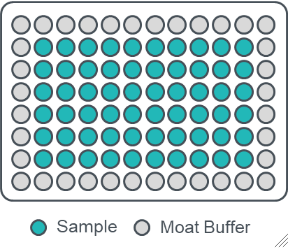
Figure 3.1: Use the moat options, MoatBuffer, MoatVolume and MoatSize to create an outer ring of wells filled with buffer. This has been shown to decrease evaporation during long reads.
MoatVolume
Default Calculation: Automatically set to the RecommendedFillVolume of the assay plate if informed, or 75% of the MaxVolume of the assay plate if not, if any other moat options are specified.
MoatBuffer
RetainCover
Indicates if the plate seal or lid on the assay container should not be taken off during measurement to decrease evaporation. When this option is set to True, injections cannot be performed as it's not possible to inject samples through the cover.
Absorbance Measurement
NumberOfReadings
Number of redundant readings taken by the detector to determine a single averaged absorbance reading.
Default Calculation: If a plate reader capable of adjusting NumberOfReadings is selected, resolves to 100. Otherwise resolves to Null
ReadDirection
Indicate the plate path the instrument will follow as it measures absorbance in each well, for instance reading all wells in a row before continuing on to the next row (Row).
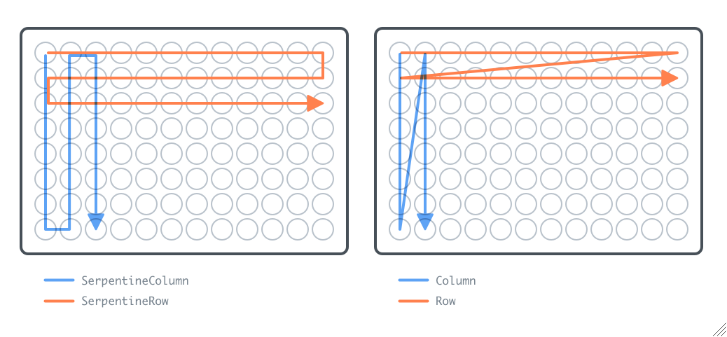
Figure 3.2: Use the ReadDirection option to control how the plate reader scans the plate during each read cycle. Choosing a more efficient path will lead to a shorter DetectionInterval. Also note that you may want to consider dripping injectors if you're working with low viscosity injection samples.
Default Calculation: Resolves to Row if a plate reader capable of adjusting read direction is selected.
Sampling
SamplingDistance
Default Calculation: Automatically resolves to Null if SamplingPattern is set to Center otherwise resolves to 80% of the diameter of the well.
SamplingDimension
Specifies the size of the grid used for Matrix sampling. For example SamplingDimension->5 will scan a 5 x 5 grid.
SamplingPattern
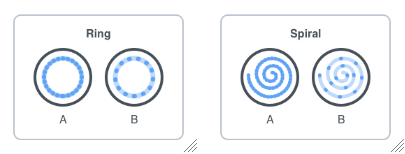
Figure 3.3: Ring sampling allows multiple measurements over a band with a specified diameter. The specified number of flashes will be equally divided over the ring and a higher number will yield to increased sampling (as seen in A). The average value of all measurements will be returned as a single data point. Spiral sampling follows the same principle as ring sampling, but covers a larger part of the well as it takes spiraling inward measurements. Again the number of flashes determines if the well is highly sampled (A) or lightly (B). Note that matrix sampling is not possible with absorbance spectroscopy readings.
Sample Prep Options
Preparatory Incubation
Incubate
Indicates if the SamplesIn should be incubated at a fixed temperature prior to starting the experiment or any aliquoting. Sample Preparation occurs in the order of Incubation, Centrifugation, Filtration, and then Aliquoting (if specified).
Default Calculation: Resolves to True if any of the corresponding Incubation options are set. Otherwise, resolves to False.
IncubationTemperature
Temperature at which the SamplesIn should be incubated for the duration of the IncubationTime prior to starting the experiment.
Pattern: ((Null | (Ambient | RangeP[$MinIncubationTemperature, $MaxIncubationTemperature])) | Automatic) | Null
IncubationTime
Duration for which SamplesIn should be incubated at the IncubationTemperature, prior to starting the experiment.
Mix
Default Calculation: Automatically resolves to True if any Mix related options are set. Otherwise, resolves to False.
MixType
Default Calculation: Automatically resolves based on the container of the sample and the Mix option.
MixUntilDissolved
Indicates if the mix should be continued up to the MaxIncubationTime or MaxNumberOfMixes (chosen according to the mix Type), in an attempt dissolve any solute. Any mixing/incubation will occur prior to starting the experiment.
Default Calculation: Automatically resolves to True if MaxIncubationTime or MaxNumberOfMixes is set.
MaxIncubationTime
Maximum duration of time for which the samples will be mixed while incubated in an attempt to dissolve any solute, if the MixUntilDissolved option is chosen. This occurs prior to starting the experiment.
Default Calculation: Automatically resolves based on MixType, MixUntilDissolved, and the container of the given sample.
IncubationInstrument
Default Calculation: Automatically resolves based on the options Mix, Temperature, MixType and container of the sample.
Pattern: ((Null | ObjectP[{Model[Instrument, Roller], Object[Instrument, Roller], Model[Instrument, OverheadStirrer], Object[Instrument, OverheadStirrer], Model[Instrument, Vortex], Object[Instrument, Vortex], Model[Instrument, Shaker], Object[Instrument, Shaker], Model[Instrument, BottleRoller], Object[Instrument, BottleRoller], Model[Instrument, Roller], Object[Instrument, Roller], Model[Instrument, Sonicator], Object[Instrument, Sonicator], Model[Instrument, HeatBlock], Object[Instrument, HeatBlock]}]) | Automatic) | Null
AnnealingTime
Minimum duration for which the SamplesIn should remain in the incubator allowing the system to settle to room temperature after the IncubationTime has passed but prior to starting the experiment.
IncubateAliquotContainer
The desired type of container that should be used to prepare and house the incubation samples which should be used in lieu of the SamplesIn for the experiment.
Pattern: ((Null | (ObjectP[Model[Container]] | {GreaterEqualP[1, 1] | (Automatic | Null), (ObjectP[{Model[Container], Object[Container]}] | _String) | Automatic})) | Automatic) | Null
IncubateAliquotDestinationWell
The desired position in the corresponding IncubateAliquotContainer in which the aliquot samples will be placed.
Default Calculation: Automatically resolves to A1 in containers with only one position. For plates, fills wells in the order provided by the function AllWells.
IncubateAliquot
The amount of each sample that should be transferred from the SamplesIn into the IncubateAliquotContainer when performing an aliquot before incubation.
Default Calculation: Automatically set as the smaller between the current sample volume and the maximum volume of the destination container.
Preparatory Centrifugation
Centrifuge
Indicates if the SamplesIn should be centrifuged prior to starting the experiment or any aliquoting. Sample Preparation occurs in the order of Incubation, Centrifugation, Filtration, and then Aliquoting (if specified).
Default Calculation: Resolves to True if any of the corresponding Centrifuge options are set. Otherwise, resolves to False.
CentrifugeInstrument
Pattern: ((Null | ObjectP[{Model[Instrument, Centrifuge], Object[Instrument, Centrifuge]}]) | Automatic) | Null
CentrifugeIntensity
The rotational speed or the force that will be applied to the samples by centrifugation prior to starting the experiment.
CentrifugeTime
CentrifugeTemperature
The temperature at which the centrifuge chamber should be held while the samples are being centrifuged prior to starting the experiment.
CentrifugeAliquotContainer
The desired type of container that should be used to prepare and house the centrifuge samples which should be used in lieu of the SamplesIn for the experiment.
Pattern: ((Null | (ObjectP[Model[Container]] | {GreaterEqualP[1, 1] | (Automatic | Null), (ObjectP[{Model[Container], Object[Container]}] | _String) | Automatic})) | Automatic) | Null
CentrifugeAliquotDestinationWell
The desired position in the corresponding AliquotContainer in which the aliquot samples will be placed.
Default Calculation: Automatically resolves to A1 in containers with only one position. For plates, fills wells in the order provided by the function AllWells.
CentrifugeAliquot
The amount of each sample that should be transferred from the SamplesIn into the CentrifugeAliquotContainer when performing an aliquot before centrifugation.
Default Calculation: Automatically set as the smaller between the current sample volume and the maximum volume of the destination container.
Preparatory Filtering
Filtration
Indicates if the SamplesIn should be filter prior to starting the experiment or any aliquoting. Sample Preparation occurs in the order of Incubation, Centrifugation, Filtration, and then Aliquoting (if specified).
Default Calculation: Resolves to True if any of the corresponding Filter options are set. Otherwise, resolves to False.
FiltrationType
Default Calculation: Will automatically resolve to a filtration type appropriate for the volume of sample being filtered.
FilterInstrument
Default Calculation: Will automatically resolved to an instrument appropriate for the filtration type.
Pattern: ((Null | ObjectP[{Model[Instrument, FilterBlock], Object[Instrument, FilterBlock], Model[Instrument, PeristalticPump], Object[Instrument, PeristalticPump], Model[Instrument, VacuumPump], Object[Instrument, VacuumPump], Model[Instrument, Centrifuge], Object[Instrument, Centrifuge], Model[Instrument, SyringePump], Object[Instrument, SyringePump]}]) | Automatic) | Null
Filter
The filter that should be used to remove impurities from the SamplesIn prior to starting the experiment.
Default Calculation: Will automatically resolve to a filter appropriate for the filtration type and instrument.
Pattern: ((Null | ObjectP[{Model[Container, Plate, Filter], Model[Container, Vessel, Filter], Model[Item, Filter]}]) | Automatic) | Null
FilterMaterial
The membrane material of the filter that should be used to remove impurities from the SamplesIn prior to starting the experiment.
Default Calculation: Resolves to an appropriate filter material for the given sample is Filtration is set to True.
PrefilterMaterial
The material from which the prefilter filtration membrane should be made of to remove impurities from the SamplesIn prior to starting the experiment.
FilterPoreSize
The pore size of the filter that should be used when removing impurities from the SamplesIn prior to starting the experiment.
Default Calculation: Resolves to an appropriate filter pore size for the given sample is Filtration is set to True.
PrefilterPoreSize
The pore size of the filter; all particles larger than this should be removed during the filtration.
FilterSyringe
Default Calculation: Resolves to an syringe appropriate to the volume of sample being filtered, if Filtration is set to True.
Pattern: ((Null | (ObjectP[{Model[Container, Syringe], Object[Container, Syringe]}] | _String)) | Automatic) | Null
FilterHousing
The filter housing that should be used to hold the filter membrane when filtration is performed using a standalone filter membrane.
Default Calculation: Resolve to an housing capable of holding the size of the membrane being used, if filter with Membrane FilterType is being used and Filtration is set to True.
Pattern: ((Null | ObjectP[{Model[Instrument, FilterHousing], Object[Instrument, FilterHousing]}]) | Automatic) | Null
FilterIntensity
Default Calculation: Will automatically resolve to 2000 GravitationalAcceleration if FiltrationType is Centrifuge and Filtration is True.
FilterTime
Default Calculation: Will automatically resolve to 5 Minute if FiltrationType is Centrifuge and Filtration is True.
FilterTemperature
The temperature at which the centrifuge chamber will be held while the samples are being centrifuged during filtration.
Default Calculation: Will automatically resolve to 22 Celsius if FiltrationType is Centrifuge and Filtration is True.
FilterContainerOut
The desired container filtered samples should be produced in or transferred into by the end of filtration, with indices indicating grouping of samples in the same plates, if desired.
Default Calculation: Automatically set as the PreferredContainer for the Volume of the sample. For plates, attempts to fill all wells of a single plate with the same model before using another one.
Pattern: ((Null | ((ObjectP[{Model[Container], Object[Container]}] | _String) | {GreaterEqualP[1, 1] | Automatic, (ObjectP[{Model[Container], Object[Container]}] | _String) | Automatic})) | Automatic) | Null
FilterAliquotDestinationWell
The desired position in the corresponding AliquotContainer in which the aliquot samples will be placed.
Default Calculation: Automatically resolves to A1 in containers with only one position. For plates, fills wells in the order provided by the function AllWells.
FilterAliquotContainer
The desired type of container that should be used to prepare and house the filter samples which should be used in lieu of the SamplesIn for the experiment.
Pattern: ((Null | (ObjectP[Model[Container]] | {GreaterEqualP[1, 1] | (Automatic | Null), (ObjectP[{Model[Container], Object[Container]}] | _String) | Automatic})) | Automatic) | Null
FilterAliquot
The amount of each sample that should be transferred from the SamplesIn into the FilterAliquotContainer when performing an aliquot before filtration.
Default Calculation: Automatically set as the smaller between the current sample volume and the maximum volume of the destination container.
FilterSterile
Default Calculation: Resolve to False if Filtration is indicated. If sterile filtration is desired, this option must manually be set to True.
Aliquoting
Aliquot
Indicates if aliquots should be taken from the SamplesIn and transferred into new AliquotSamples used in lieu of the SamplesIn for the experiment. Note that if NumberOfReplicates is specified this indicates that the input samples will also be aliquoted that number of times. Note that Aliquoting (if specified) occurs after any Sample Preparation (if specified).
AliquotSampleLabel
AliquotAmount
Default Calculation: Automatically set as the smaller between the current sample volume and the maximum volume of the destination container if a liquid, or the current Mass or Count if a solid or counted item, respectively.
Pattern: ((Null | (RangeP[1*Microliter, 20*Liter] | RangeP[1*Milligram, 20*Kilogram] | GreaterP[0*Unit, 1*Unit] | GreaterP[0., 1.] | All)) | Automatic) | Null
TargetConcentration
The desired final concentration of analyte in the AliquotSamples after dilution of aliquots of SamplesIn with the ConcentratedBuffer and BufferDiluent which should be used in lieu of the SamplesIn for the experiment.
TargetConcentrationAnalyte
Default Calculation: Automatically set to the first value in the Analytes field of the input sample, or, if not populated, to the first analyte in the Composition field of the input sample, or if none exist, the first identity model of any kind in the Composition field.
AssayVolume
Default Calculation: Automatically determined based on Volume and TargetConcentration option values.
ConcentratedBuffer
The concentrated buffer which should be diluted by the BufferDilutionFactor in the final solution (i.e., the combination of the sample, ConcentratedBuffer, and BufferDiluent). The ConcentratedBuffer and BufferDiluent will be combined and then mixed with the sample, where the combined volume of these buffers is the difference between the AliquotAmount and the total AssayVolume.
BufferDilutionFactor
The dilution factor by which the concentrated buffer should be diluted in the final solution (i.e., the combination of the sample, ConcentratedBuffer, and BufferDiluent). The ConcentratedBuffer and BufferDiluent will be combined and then mixed with the sample, where the combined volume of these buffers is the difference between the AliquotAmount and the total AssayVolume.
Default Calculation: If ConcentratedBuffer is specified, automatically set to the ConcentrationFactor of that sample; otherwise, set to Null.
BufferDiluent
The buffer used to dilute the aliquot sample such that ConcentratedBuffer is diluted by BufferDilutionFactor in the final solution. The ConcentratedBuffer and BufferDiluent will be combined and then mixed with the sample, where the combined volume of these buffers is the difference between the AliquotAmount and the total AssayVolume.
Default Calculation: Automatically resolves to Model[Sample, "Milli-Q water"] if ConcentratedBuffer is specified; otherwise, resolves to Null.
AssayBuffer
The buffer that should be added to any aliquots requiring dilution, where the volume of this buffer added is the difference between the AliquotAmount and the total AssayVolume.
Default Calculation: Automatically resolves to Model[Sample, "Milli-Q water"] if ConcentratedBuffer is not specified; otherwise, resolves to Null.
AliquotSampleStorageCondition
The non-default conditions under which any aliquot samples generated by this experiment should be stored after the protocol is completed.
DestinationWell
The desired position in the corresponding AliquotContainer in which the aliquot samples will be placed.
Default Calculation: Automatically resolves to A1 in containers with only one position. For plates, fills wells in the order provided by the function AllWells.
AliquotContainer
The desired type of container that should be used to prepare and house the aliquot samples, with indices indicating grouping of samples in the same plates, if desired. This option will resolve to be the length of the SamplesIn * NumberOfReplicates.
Default Calculation: Automatically set as the PreferredContainer for the AssayVolume of the sample. For plates, attempts to fill all wells of a single plate with the same model before aliquoting into the next.
Pattern: (((ObjectP[{Model[Container], Object[Container]}] | _String) | (Automatic | Null) | {GreaterEqualP[1, 1] | (Automatic | Null), (ObjectP[{Model[Container], Object[Container]}] | _String) | (Automatic | Null)} | {((ObjectP[{Model[Container], Object[Container]}] | _String) | (Automatic | Null))..} | {({GreaterEqualP[1, 1] | (Automatic | Null), (ObjectP[{Model[Container], Object[Container]}] | _String) | (Automatic | Null)} | (Automatic | Null))..}) | Automatic) | Null
AliquotPreparation
Default Calculation: Automatic resolution will occur based on manipulation volumes and container types.
ConsolidateAliquots
Sample Preparation
PreparatoryPrimitives
Specifies a sequence of transferring, aliquoting, consolidating, or mixing of new or existing samples before the main experiment. These prepared samples can be used in the main experiment by referencing their defined name. For more information, please reference the documentation for ExperimentSampleManipulation.
Protocol Options
Post Experiment
MeasureWeight
Indicates if any solid samples that are modified in the course of the experiment should have their weights measured and updated after running the experiment.
MeasureVolume
Indicates if any liquid samples that are modified in the course of the experiment should have their volumes measured and updated after running the experiment.
ImageSample
Example Calls
Quantification
If quantifying, it is recommended to use the fixed path length Lunatic plate reader. The specified wavelength will be the one on which the extinction cofficient will be obtained and absorbance will be calculated:

To indicate which component in a mixture will be quantified, specify the QuantificationAnalyte option. If not specified, AbsorbanceSpectroscopy will call the Experiment`Private`selectAnalyteFromSample on the input samples to guess what component to quantify:

Set the sample to set as the blank to subtract when quantifying. If not specified, will be set to water:

Injections
To specify injections, use the InjectionSample and InjectionVolume options if using the PHERAstar, CLARIOstar, or Omega. The sample and volume options are index matched to the input samples allowing you to control the wells which receive injections and the volumes of those injections. In the example below, 50 Microliter of myInjectionSample1 is injected into each well, and then myInjectionSample2 is injected at different volumes into the first two wells but not the third:

Plate Reader Mixing
The assay plate can be mixed during readings by specifying any of the PlateReaderMix options if using the PHERAstar, CLARIOstar, or Omega:
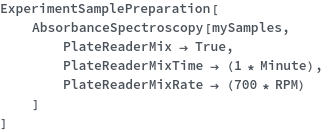
Preferred Input Containers
Warnings and Errors
-
Messages
Possible Issues
Multiple components
If a mixture exists with overlapping extinction coefficients, the calculated concentration may be off because the full absorbance will be attributed to a single component rather than the multiple components of the sample.
Readings outside of linear range
If the output data is outside of the recommended linear range of the instrument, AnalyzeAbsorbanceQuantification will throw a warning because quantifications may be less reliable.
Incompatible solvents
If the sample is contained in a volatile solvent (say methanol or acetone), the 2.1 μL of solvent will evaporate before any data can be collected. For example, when plotting the following data Object[Data, AbsorbanceSpectroscopy, "id:zGj91a7n4JNn"], an error will be thrown since there is no valid data collected.
